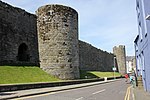Llŷn Coastal Path
Coastal paths in WalesLlŷn PeninsulaLong-distance footpaths in WalesRecreational walks in WalesTourism in Gwynedd ... and 1 more
Use British English from January 2017

The Llŷn Coastal Path is a waymarked 146-kilometre (91 mi) long-distance footpath running along the coast of the Llŷn Peninsula from Caernarfon to Porthmadog in Gwynedd, north-west Wales. A large part of the Llŷn Peninsula is designated an Area of Outstanding Natural Beauty.Devised and implemented by Gwynedd County Council and the Countryside Council for Wales, the path opened in 2006, though it has since been changed and improved. This work is continuing as part of the path's integration into the Wales Coast Path, an 870-mile (1,400 km) long-distance walking route around the whole coast of Wales from Chepstow to Queensferry.
Excerpt from the Wikipedia article Llŷn Coastal Path (License: CC BY-SA 3.0, Authors, Images).Llŷn Coastal Path
Saint David's Road,
Geographical coordinates (GPS) Address Nearby Places Show on map
Geographical coordinates (GPS)
| Latitude | Longitude |
|---|---|
| N 53.145 ° | E -4.269 ° |
Address
St. Davids Road
Saint David's Road
LL55 1EG , Caernarfon
Wales, United Kingdom
Open on Google Maps









